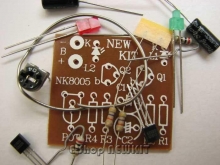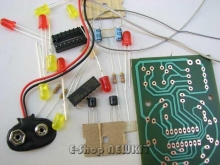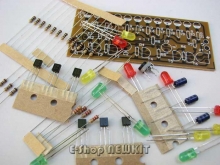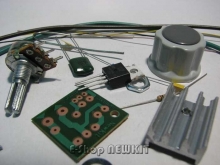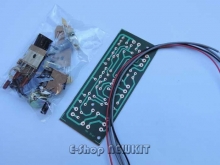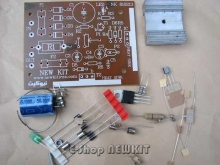ماژول تغذیه برد بورد 5V , 3.3V
The MB102 is a breadboard power supply module manufactured by the YwRobot Corporation in China. This module has the marking 545043 and MB V2 on the printed circuit board (PCB). It provides dual 5 V and 3.3 V power rails, and has a multi-purpose female USB socket.
I decided to review this one and test it out because it seems to be low-cost, and there does not seem to be much information available in the way of a manual or any documentation. Hence, this article might prove to be useful to anyone considering buying it or needs to know how it works. The one I received came with a small sheet of paper stating the input voltage and current levels.
I performed a short circuit test by shorting the power supply rails for a full one minute, and surprisingly the voltage regulators are still operating properly. I noticed that the 5 V regulator heated up, but when the short was taken away it cooled down and continued to operate within normal parameters. I then repeated the test to measure the loading on the power source when the voltage regulator output was shorted, and I am glad to say that the source was protected.
Since the green power LED is connected to the output rail, when I applied a short to either of the voltage rails it would go out, hence this is an excellent indicator of a short in the power rails that the hobbyist can make use of when building breadboard projects.
YwRobot appears to be a Chinese firm that sells a lot of these to their domestic educational establishments; however, some of their products can end up on eBay, and Amazon, selling to worldwide markets. Nevertheless, it is amazing that they can sell this for less than £2.00 including postage!
There is a green LED to indicate the presence of power, and an ON / OFF latching switch to control the power to the board. On this particular model and version, the centre pin of the barrel socket is positive; however, please double check with the manufacturer’s instructions, in case they have made any changes. You have to push the switch IN to use this device.
The operating instructions state that the input voltage through the barrel socket must be between 6.5 V and 12 V. Hence, if you wish to use it to its maximum capability you will need to remain in that range. This is a non-adjustable fixed power supply model, which is good enough for most applications. The manual states maximum output current to be 700 mA. However, it is probably better to use much lower voltages and current to be on the safe side in case you make a mistake on your breadboard circuit.
Jumper Pins and Headers
Jumper pins are utilised for selecting the voltage levels on each side of the breadboard power rails. You can choose between 5 V, OFF, and 3.3 V. There are two sets of jumper selectors for each side of the breadboard power rails; hence, you can have any combination of voltages on either rail. There are also header pins for tapping off voltages, using a cable or jumper wires.
Voltage Regulator AMS1117 Spec
The AMS1117 is a voltage regulator manufactured by Advanced Monolithic Systems. There are two regulators where one regulator establishes a 3.3 V rail, whilst another establishes the 5 V rail. These are a good make of components found in a SOT-223 package. Their documentation states that this series can provide a maximum output current of 1 A, and the absolute maximum input voltage rating is 15 V.
The documentation indicates that these regulators have built-in protection against short-circuit through power limiting circuitry. There is also thermal overload protection circuitry, which will shut-down the regulator should its junction temperature reach 165 °C.
These regulators also have internal diode protection and can handle transient surge currents from 50 A to 100 A.
This is a high efficiency low dropout regulator, which can operate down to 1 V. It has a 1 V input-to-output differential and therefore useful for battery powered applications. Line regulation is 1.2 % and maximum load regulation 0.4 %.
The AMS1117 series is an excellent choice for creating adjustable power supplies as well. The package provides a 1.25 V reference voltage from the adjust pin, and with a pair of resistors in a voltage divider network the regulated output can be adjusted. The documentation is also very clear and comprehensive in its use.
How to use a Breadboard Power Supply
This is a plug-in power supply and the headers below the board simply plug-in to the breadboard.
Once plugged in, the voltage rails to both sides on the breadboard then provide power. You then use the yellow jumpers to select the voltage levels required. This is a dual output 3.3 V, 5 V regulated board and you can have either voltage on either rail on the breadboard, which is very useful.
PCB
The PCB manufacturing is of good standard, and the markings indicate the model MB V2, known as MB102. This is obviously a double-sided board that is machine assembled to a good quality standard. There are two sets of mounting header pins, and the ones on the front are if you want to use the holes on the outermost edge of the breadboard thereby using a least number of tie points.MB102 Breadboard Specification
- Locking ON / OFF Switch
- LED Power Indicator
- Input Voltage: 6.5 V to 12 V (DC)
- Output Voltage: 3.3 V / 5 V
- Maximum Output Current: 700 mA
- Power Rails 0 V, 3.3 V, 5 V on Breadboard
- Two Groups of Header Pins
- Size: 5.3 cm × 3.5 cm
The manufacturer may make revision changes to their product, changing their voltage regulators and components. You should therefore always follow the instructions that came with your product.
When you receive your board, it is a good idea to check the output voltage levels with a digital meter to make sure that it is operating correctly and providing the correct voltage levels. You should get exactly 3.3 V and 5 V at the outputs. Although the manual states the maximum input voltage to be 12 V, it is better to keep to the low range such as 6.5 V.
You should thoroughly check your breadboard project circuit, and double check all the voltages before you connect it to anything else.

